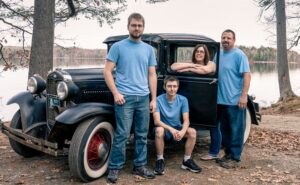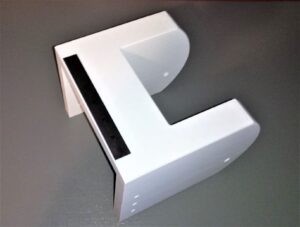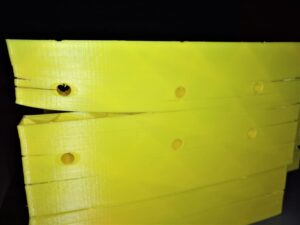Team #9 Electric Scooter
Welcome!
This webpage is dedicated to capstone team 9’s project updates.
Team 09 was tasked to design and produce a 3D printed electric scooter to be assembled in a home environment via a purchasable kit. Some other specifications from the client include a maximum weight restriction of 300 lb, a top speed of 10-15 mph. The scooter should also be powerful enough to climb 15% inclines without stopping, and efficient enough to travel 1 mile on a single charge. The largest challenge facing our group is the structural integrity of the scooter structure. The scooter’s structure must be able to withstand loading comparable to falling off a 4in curb in its maximum weight condition without failure.
About the team:
Mike Perry: I’m from Bow NH and live in a military family, I have a great love of tinkering and hands on work, and a great fascination with swords and medieval armory
Devin Jolicoeur: I am from Etna, ME and I have always had an interest in pretty much anything mechanical. I enjoy working on old cars and bringing them back to life.
Devin Perkins: I’m from Windham ME, and I enjoy working with computers. I love the Star Wars universe and Marvel universe.
Andrew Keithley: I am a senior student in the MET program from Chelsea Maine, besides my school work my free time is mostly spent skiing, camping, and playing hockey.
Update 1 (11/12/20): The team has found a suitable candidate for the scooter’s deck design and are now designing a joining system for the decks sections. Once this is done the team will print a model of the design and begin testing on the design in a bending scenario.
Update 2 (11/19/20): The team’s deck design is now completed and is getting prepared to be printed. Once this is complete the team will begin to test the deck design. This will also allow the team to begin the drive system and test it with the Arduino throttle controller.
Update 3 (11/23/20): Updates have been made to the scooters front end design to make it perform better in the FEA models. Updates have also been made to the joints with the inclusion of side plates, and to the entirety of the deck structure by including fasteners on the top edge of joining sections.
Update 4 (11/30/20): Printing highs and lows: The team’s first part has been successfully printed! Scooter rear end in pla can be seen in the picture below. The team has also attempted a print in ABS for a joint section, however the print has failed. The second image in this post shows the de-lamination of the failed print, which is a separation of the print between layers. Luckily this print was just a mock-up to test the fit of the joints until the team gets more pla.
P.S. Also with the ever-changing times the team no longer has access to the 3D printing club so this will be another hurdle to jump.
Update 5 (12/7/20): The team has begun work on IR 2. This will be most of the work until it’s due date on 12/09/20, some things the team need to finish are the drawing package of the scooter, and to design the schematic of the electrical system. The team has also procured a new means of printing parts. Devin Jolicoeur has offered his new Ender 3 pro to the group for use, this is perfect because it has nearly the same print size restrictions as the i3 MK3’s the group were basing our prints around before.
Update 6 (1/29/21): The team is currently working on revising Interim Report #2 as well as gathering all the components required to produce a working prototype scooter. The team has also finalized their client contract and has ordered all of the components required for the drive train of the scooter as well as more 3d printing filament to print the rest of the scooter’s deck. The team should have a functioning prototype within the next few weeks. After that, the team will begin refining the scooter design and verifying the safety and structural integrity of the scooter deck.
Update 7 (02/12/21): The team has found a fit error with the scooters rear end and rear wheel. This has been updated and will be run through an FEA to prove its viability. The new rear end can be seen in the photo below.

Update 8 (02/23/21): The teams motor has arrived and is currently being tested with the Arduino code and electronics to ensure everything is working as expected. The photos below document the testing process.


Update 9 (03/05/21): The team is currently preparing for its design review, this includes re-rerunning all past analysis and correcting errors, and going over the drawing package to fix any errors.
Update 10 (04/03/21): The team began building of the final prototype today, the photos below document the process. Note the fit error with the motor and the scooters sidewalls, this was due to incorrect specifications from the vendor, the team will redesign the deck section to accommodate the actual dimensions of the motor


Update 11 (04/15/21): The new deck section has been completed and final assembly and wiring was completed. The photo below was taken from the first video’s of the scooter running.
Update 12: (04/21/21): The scooters testing has been completed, and the team is beginning work to prepare for the Maine day presentations. Test values show the top speed of the scooter to be 11.5 mph, and a range of just under 2 miles between charges, the photos below show the team during the testing process.
Update 13 (final update): The team has just handed in the final report and all other information. We would like to thank the University of Maine and Professors Howorth and Ellis for the opportunity to work on this project!









